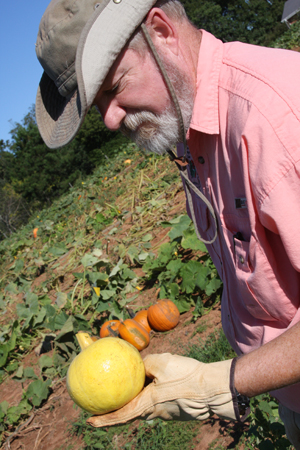Heading to a local pumpkin patch to pick the season’s best is a time-honored fall family activity. Thanks to University of Georgia researchers, a better, Georgia-specific pumpkin is available for carving or baking.
“Most of the pumpkins traditionally grown commercially in Georgia are Cucurbita pepo types,” said George Boyhan, a horticulturist with the UGA College of Agricultural and Environmental Sciences. “They’re in the same species as summer squash. And they’re highly susceptible to viruses and other foliar diseases.”
Even with an aggressive program to control tiny insect pests called aphids, aphid-transmitted viruses can quickly devastate the crop, he said, at times resulting in complete loss.
But Orange Bulldog is not so weak on the vine. The improved variety — developed from germplasm collected in the jungles of South America – has greater levels of resistance to viruses than conventional pumpkins.
When Boyhan and retired CAES horticulturists Gerard Krewer and Darbie Granberry began working with the jungle seed, they discovered long, flat pumpkins, or ones not easily carved into jack-o’-lanterns.
The team worked to develop a more disease-resistant variety with a good jack-o’-lantern shape that’s adapted to Georgia’s climate. Orange Bulldog debuted in 2004.
It consistently yields 13,000 pounds to 20,000 pound per acre in northern and southern Georgia. Boyhan is now working to develop a variety with more uniformity in shape and color but with the same disease resistance as Orange Bulldog.
“The goal of the variety was to produce a pumpkin with higher levels of disease resistance,” he said. “So, it lends itself to organic farming where herbicides and fungicides are limited to a few organic compounds. We are looking at small growers and farmers markets and organic fruit seems to fit there.”
Organic seeds for Orange Bulldog will be available for next year’s crop.
The pumpkin variety has a considerable amount of variability, something shoppers at roadside stands and pick-your-own farms find appealing.
“People really like the variation of the pumpkin, they can use it for variety in decorating,” said Raymond Joyce, the UGA Cooperative Extension coordinator in Laurens County.
T&T Farms, a pick-your-own farm in Dudley, added an agritourism activity for school groups as well as an additional fall crop when they planted three-acres of Orange Bulldog this year. Joyce said he was surprised to see how well the pumpkin did in the field. It was grown without irrigation and had to be sprayed only once with a fungicide and then once with a herbicide.
“We had planted pumpkins in the past, but they always grew out too soon and never did too good,” said Nancy Tomlinson, owner of T&T Farms. “The neat thing about these pumpkins is they are all different. Some are long. Others are squatty. The color varies from light-yellow to bronze or deep orange. And some have green mingled in. It is neat to watch the variation in size, shape and color all come off the same vine.”
Having a successful pumpkin crop meant more business to the family farm this season. So did adding a corn maze and hayrides.
Apart from looking good, Orange Bulldog tastes good, too. In its immature state, it is bright yellow and can be prepared and eaten like summer squash. It’s particularly good sautéed with Vidalia onions, Boyhan said. The meat of a mature pumpkin can be cubed and cooked to make pumpkin pie filling.
“I’ve used it in cakes, pies and candy and cooked it like squash. You name it, we’ve tried it,” Tomlinson said.
To find pick-your-own pumpkin and other fruit or vegetable patches in your area, visit the Georgia Market Maker Web site at ga.marketmaker.uiuc.edu.




